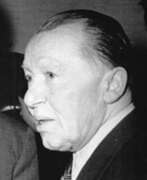Engravers German Democratic Republic


Conrad Felixmüller was a twentieth-century German artist, born Conrad Felix Müller. He is known as a painter, graphic artist, illustrator and printmaker, a representative of the New Materiality movement, who worked in the Expressionist style.
Felixmüller created about 2,500 paintings and graphic drawings, the main motif of which was the human being. The artist considered himself a socially critical expressionist, and his works reflected scenes from everyday life. In the 1930s, many of his works were confiscated by the Nazis as examples of degenerate art and destroyed. As a result of the bombing of Berlin in 1944, Felixmüller lost much of his work.


Max Lingner was a German artist of the first half of the twentieth century. He is known as a painter, graphic artist, muralist and teacher.
Max Lingner at the beginning of his career, studying in Paris, was influenced by Impressionism. He worked as a painter and engraver for the newspaper Le Monde. Joining the French Communist Party, Lingner fought on the Republican side during the Spanish Civil War and fought against the Nazis in the Resistance Movement in France. After returning to the GDR, he became a professor and created the monumental panel "Building the Republic" in the House of Ministers. The artist donated the 40 paintings, prints and watercolors he had brought back to the state.


Wolfgang Opitz is a contemporary German artist known for his abstract paintings.
Wolfgang Opitz studied art from 1964 to 1968 in Erfurt and Dresden. He met A. R. Penck, with whom he made many experimental films in 1969. They also founded the group Lücke in 1971, together with artists Harald Gallasch and Steffen Koonert (Turk). In 1989, Opitz fled East Germany to the West, where he received a teaching position at Lüneburg University in 1991.









